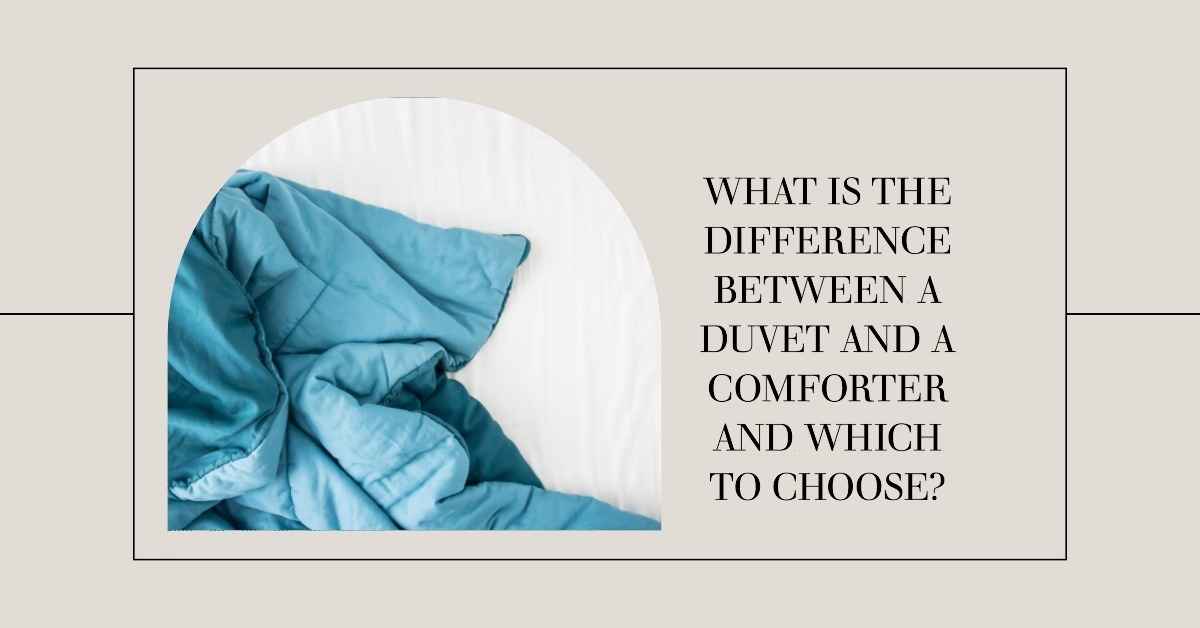
What Is the Difference Between a Duvet and a Comforter and Which to Choose?
If you're having trouble figuring out the exact difference between a duvet and a comforter – you’re not alone. Many people aren’t sure about the distinctions between the two, and more importantly, how to choose the right type of blanket for their home.
But we at MyTickie have your back. Today, we’re going to talk about the difference between a duvet and a comforter and what to consider when buying either for you. So let’s get into it.
What Is a Duvet?
In simplest terms, a duvet is a quilted blanket that has a synthetic or natural filling. The word duvet itself actually comes from a French word that means down, referring to the type of filling it usually had.
A duvet tends to have intricate stitching on it to ensure the filling (natural or otherwise) is distributed evenly. What’s more, stitching is a really important factor when it comes to keeping the duvet plush for a long time. With that said, having a crisscrossing pattern is key because the plushness and warmth aren’t a guarantee otherwise.
One way to look at a duvet is as an insert because it always requires an outer layer – or a duvet cover. It is a fabric case that finds around the duvet and closes with zips, buttons, or snaps.
A duvet cover has three main purposes: convenience, comfort, and design. It also helps protect a duvet from stains and spills and is much easier to wash and maintain than the duvet itself.
Types of Duvets
Duvets come in many different sizes, colours, and price ranges. However, the main difference between them is in the type of fill inside, which is either from natural or synthetic materials.
Natural
A natural filling can be goose or duck down, wool, cotton, or silk. The two types that you’ll see often in stores are the duck or goose down duvets because they’re incredible insulators.
Another great thing about natural filing is that it’s usually machine washable, durable, biodegradable, and sometimes even hypoallergenic. However, all those fantastic qualities also tend to come with a pretty high price tag. That’s why lots of people consider going for the synthetic.
Synthetic
Those allergic to duck/goose down or looking for something more budget-friendly should consider a duvet with a synthetic filling. Made with either microfibre or hollowfibre, a synthetic filling is a great insulator and often sweat-wicking.
With that said, a downside to this type of filling is that it isn’t as breathable as the natural one. That means that it traps heat, which is why it might not be the best option for those who tend to run hot during the night.
What Is a Comforter?
A comforter consists of two pieces of fabric, sewn together and stuffed with a soft filling like down, silk, cotton, wool, or polyester. It’s a type of quilted blanket that most people use as a top sheet to complete a bedding set.
A comforter will usually consist of three layers, which means that, no matter what it’s filled with, it still provides loads of warmth. Comforters come in many different sizes and styles, and they don’t require any outer coverings.
Types of Comforters
Depending on how you sleep, where you live, and what you need, the biggest decision to make when buying a comforter is the filling.
If you go with the duck or goose down filling, you’ll get a very warm and heavy comforter with breathability. However, there’ll also be a high price tag to pay.
On the other hand, cotton is a more accessible type of natural filling that is lightweight and good for warm climates. Silk is another natural option that is incredibly luxurious and has a price tag to match.
A great and less expensive alternative to natural fillings is polyester, or better yet – Minky. Minky, the stuff dreams are made of, is a type of polyester that is durable yet soft, warm yet breathable. It offers natural temperature regulation, making it perfect for any kind of weather and any type of sleeper. Not only that, but Minky is also a moisture-wicking, hypoallergenic fabric.
What Is the Difference Between a Duvet and a Comforter?
The biggest difference between a duvet and a comforter isn’t actually in their use or the materials they tend to be filled with. They are both used to keep sleepers warm and provide a well-rested night.
However, their main difference is in the outer layer. You see, comforters, like the ones MyTickie offers, are ready to use right out of the bag. Their fun and charming style and outer shell make them the perfect addition to any room – no cover needed.
On the other hand, duvets more typically serve as inserts and require a cover. The covers are usually sold separately and have their own unique set of maintenance rules.
Of course, depending on your needs, wants and style, you’ll be able to decide between the two. If you don’t want the hassle of having to change the cover every time and washing it separately, go for the comforter. It will give your bedroom an immediate sense of style.
But if you like changing up your style and want your blankets to show it, you can always go for the duvet. You should also consider a duvet if you feel like your washing machine couldn’t support the size and weight of a comforter.
To Sum Up: What Is the Difference Between a Duvet and a Comforter?
Hopefully, we’ve helped you figure out the difference between a duvet and a comforter and how to distinguish one from another. As you can see, they have a lot of things in common, which is why making your decision between the two might not be easy.
But even if you’re still on the fence or know that the comforter is going to be right for you – MyTickie is going to be the place for you.
Our soft and plush comforters come in many different styles and sizes, so we’re sure we have something for everyone. Not only that, but choosing a MyTickie Minky comforter means that you’ll be warm and comfy all year round. So what are you waiting for?



